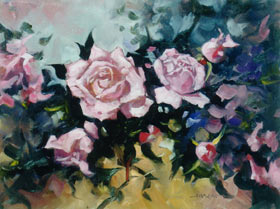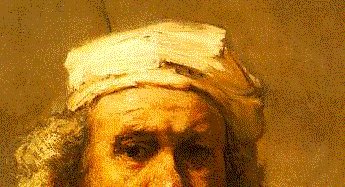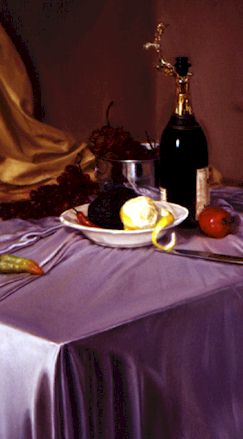4-1 THE PAINTERLY EFFECT

|
In these lessons I do not hesitate to assert that art is about illusion and great art is the total presentation of the greatest illusion. This brings me to the ‘painterly effect’ or the process of having your brush strokes or knife effects appear on the canvas as you see opposite in the detail from a pink rose I painted 'wet-in-wet' before the blooms could wilt. The full painting is shown below ... JH

|
Virgil writes:
The "painterly" approach was originally an incidental effect most common in sketches and studies, the sole purpose of which was to help the artist solve some of the problems in the execution of a more refined painting. Titian and Rembrandt became more "painterly" in their later years, when deteriorating eyesight may have hidden the irregularities from them (one hypothesis). Franz Hals painted a number of paintings in the sketch style, probably for his own amusement and/or to cover his bar tab or whatever. He was capable of more refined painting, as is evident in most of his more important commissioned portraits, but employed the faster "alla prima" approach for painting more light-hearted subjects; probably his friends or interesting subjects encountered at the tavern, where no one was likely to pose for very long.
Bouguereau has been falsely characterized as disguising his brushstrokes, but his brushwork is actually visible from up close. In reproductions the strokes do not show, because the paintings are generally large, with the main figures life-size, and the brushstrokes are small. He also used palette knife very expertly for certain effects, especially in the vegetation and other parts of the background, but generally did not employ impasto.

|
The 'painterly' style became more popular with John Singer Sargent, Anders Zorn, and Joachin Sorolla. Sargent actually worked very hard to achieve the effect that he had dashed the picture off effortlessly and accurately all at once. Many passages were scraped out and repainted over and over again until the desired appearance was accomplished. There is a certain charm in this type of painting (see opposite), but its effectiveness depends on the values and colors being registered extremely accurately, or the result just looks sloppy. Sargent's eye was precise enough to make it work. Ironically, he expressed regret, late in life, that he had not carried his paintings to a higher degree of finish. The main trick to painting in this manner is to work fast, with large hog- bristle brushes and large amounts of paint available on the palette. palette knife can also be used for certain effects. A somewhat rougher texture canvas works best for this technique, in my experience. Some subjects are more suited for this approach than others. It is well for artists to be able to paint in more than one manner, and to choose whichever technique best suits the subject at hand.
Regarding impasto highlights, the reason for this is to ensure that they remain opaque far into the future. Oil paint becomes more transparent as it ages, and the thinner the paint, the more transparent it will become. Highlights must be opaque in order to reflect the light which strikes them in the same way as it would reflect from the surface depicted.'
|
Refined Painting - 'The most advanced concepts go beyond words' ... VE

|
Rembrandt developed the technique of glazing over dried impasto for a bas- relief effect, wiping the wet glaze off the high spots and allowing it to remain in the nooks and crannies for a heightened three-dimensional effect. Used in this manner, impasto can actually enhance the illusion of the third dimension.
|
|
|
Gerome (below) insisted on a perfectly smooth surface to the painting, and forbade his students to use impasto anywhere.


|
My first instructor, who happened to be my mother, told me it makes a painting more interesting to the viewer when he or she can detect some of the artist's brushwork from up close. I still adhere to that, to a greater or lesser degree depending on what I feel is most appropriate for the picture in question, but I prefer to only leave a few, in strategic places, rather than leave them everywhere indiscriminately. My usual practice is to have them undetectable from normal viewing distance, and only become barely visible from a few inches away. In my alla prima style, which I seldom employ these days, I may let them show a bit more noticably in areas where they serve a purpose, as accents. This was generally the practice of most of the Old Masters.
I believe it is best for painters to have command of all possible visual effects, as this opens up the widest range of possibilities, and best facilitates the creation of whatever illusion is desired.' ... Virgil Elliott
left ... detail from Virgil's 'Still Life With Satin'
|
STUDENT ACTIVITY:Using paint with very little oiliness and half-inch or less hog bristle brushes paint a small 'impressionist style' picture using short thick impasto strokes. Allow 40min.
GO TO ... Virgil's 'Oil Painter's Bible'
or lesson menu
|
|
|
|





